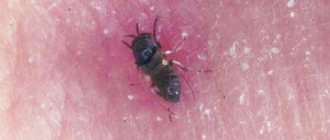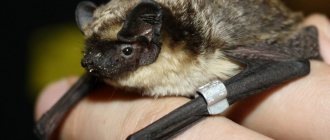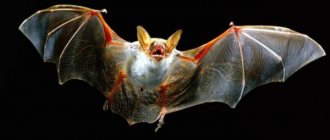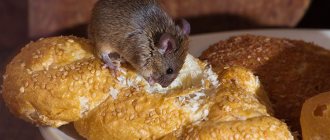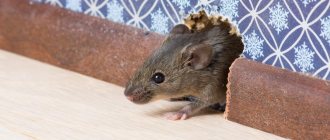- Wild animals
- >>
- Mammals
The bat has long inspired fear in humans. Many legends and stories have been invented around their unusual lifestyle and appearance. Their sharp teeth and nocturnal flights combined to create the illusion that there was potential danger when encountering them. However, in reality, everything is not so, and only a few rare species living in certain places feed on the blood of large mammals. The rest are content with insects and have nothing to do with vampirism.
Origin of the species and description
Photo: Bat
Bats are primarily amazing because they move through the air by flapping their wings like birds. However, they do this exclusively at night, without using one of the main senses - vision. They, of course, are not birds, because they themselves are viviparous and feed their young with milk. And they have nothing in common with birds, except the ability to fly, even feathers.
Video: Bat
Bats belong to the class of mammals in the order Chiroptera. There are a huge number of types. According to various sources, there are from 600 to 1000 species of bats. Of course, it is impossible to consider each species separately without being an expert on these animals.
The main types, the most common and having obvious differences, can be counted on one hand, namely:
- two-tone leather;
- giant noctule;
- white leaf-nosed plant;
- pig-nosed bat;
- great harelip;
- water bat;
- brown long-eared bat;
- dwarf pipistrelle;
- ordinary vampire;
- white-winged vampire;
- hairy vampire.
It is believed that the first bats appeared about 70 million years ago, when small arboreal mammals began to develop membranes on their sides, which later evolved into wings. It is possible that the formation of membranes was caused by a gene mutation. Scientists believe that the change in the body structure of animals occurred quite quickly, since to date not a single individual of the transitional species has been found. That is, the so-called high-speed evolution occurred.
Description
Depending on the species, the body length ranges from 35 mm to 14 cm, the head has a wide mouth slit, small eyes and large ears, each species has a different description, which, like the wings, are covered with a large number of vibrissae.
Chiropterans' vision and sense of smell are extremely weak, so they focus exclusively on sound, and hearing in most species is excellent: the hearing range is up to 190 thousand Hz. They also successfully use echolocation, picking up ultrasonic signals reflected from certain objects.
The main feature of bats is their limbs transformed into wings, the thin bones of which are ideal for flight.
The animals have greatly elongated toes of the front paws (except for the first), which, together with the legs and long forearm, form the frame for an elastic membrane, covered with a few hairs, that forms the wing (interestingly, it is completely penetrated by blood vessels, nerves and muscle fibers). On the heel of the animal there is a bone, a spur, which supports the rear edge of the membrane.
While the muscles that move the wings in birds connect to the sternum, the muscles in bats work differently. The wing is raised by several small muscles, and lowered by three muscles, with only one of them attached to the sternum.
Thus, with the movements of fingers, arms, legs, and forearm, bats can excellently maneuver, so the flight of a bat, according to the description, is distinguished by a variety of styles. They can take off not only from high points (for example, from the ceiling of a cave), but also from the earth and even water surface.
An interesting fact is that during flight, bats constantly scream, emitting ultrasonic signals through their mouth or nose. This helps them catch echoes that bounce off various objects and makes it possible, if necessary, to adjust their flight (to get around an obstacle, to find food).
Differences between bats and fruit bats
Bats differ from fruit bats primarily in the different structure of their aircraft: in fruit bats it is less developed - with wide wings, a single shoulder joint. They also differ in external description:
- They have a shorter muzzle;
- The outer ears of fruit bats form a closed ring around the ear opening;
- Bats do not have a claw on the second toe of their front feet;
- Bats have no down: they are either completely bald or covered only with shaft hair;
- The length of bats generally does not exceed 14 cm (there are species of fruit bats that reach 55 cm). The largest bat in the world is the South American large false vampire bat, which has a length of 13.5 cm and a wing size of 91 cm. Interestingly, the size of one of the smallest representatives of the species (the white bat) ranges from 37 to 47 mm.
Appearance and features
Photo: Big bat
Bats are quite small in size. The weight of the smallest species, the pig-nosed bat, is about 2 grams, while the body length of the individual is only 33 mm. This is one of the smallest representatives in general among the animal kingdom. The largest bat is the giant false vampire, whose wingspan is 75 cm, and the body weight of an adult is in the range from 150 to 200 grams.
Different species of bats differ from each other in appearance and skull structure. But they all have common external characteristics. The main difference from many animals is their wings. They are thin membranes stretched between the front and hind limbs. The wings of bats are significantly different from the wings of birds. They do not have feathers, but have long fingers to which membranes are attached.
Interesting fact: wings are not only used for flying, but also as a blanket while sleeping. Bats wrap themselves in them to keep warm.
Their hind limbs are also different. They are turned to the sides, with the knee joints back. The hind limbs are very developed. With their help, bats can hang upside down for a long time. Moreover, it is in this position that they sleep.
Almost all bats have large ears. Which is not surprising for an animal that does not have good eyesight. Ears are used by bats for echolocation and spatial orientation. The animal emits high-frequency subtle sounds, which are reflected from all objects and then perceived by the animal itself. The ears are equipped with a large network of blood vessels that nourish them. The eyes of bats, on the contrary, are very small in size. Vision is monochrome and not sharp. Although there are exceptions, for example, the California leaf-nosed bat, when hunting, relies more on its vision than on its hearing.
Most species of bats are dull in color. They are usually brown or gray in color, sometimes dark gray. This is due to the need to be undetected while hunting at night. There are also exceptions, for example, some species have white or bright red colors. The hair of animals is thick, single-tiered. In this case, the skin membrane is covered with very sparse hair.
Order Chiroptera general characteristics
Chiropterans are small animals, weighing from 2g (butterfly bats) to 1.5kg (flying dog). The distribution of representatives of the order Chiroptera is associated with climate conditions; they inhabit almost all corners of the earth, are not found in the tundra and Antarctica, and the most common habitat of bats is tropical areas. There are approximately 1,200 species, which puts them in second place in size after rodents.
The order Chiroptera includes two suborders:
- Fruit bats;
- real bats.
Representatives of the groups are similar in structure and were previously united into one suborder, but there are certain characteristics that distinguish them.
True bats have a more complex structure of the outer ear, there is no claw on the second finger, and most species are small in size. The eyes are small, do not distinguish colors and do not play a role in orientation, unlike fruit bats. All animals of the suborder have developed echolocation; fruit bats are poorly oriented by sounds.
Krylan - a representative of the order Chiroptera
Where does a bat live?
Photo: Black bat
Bats are distributed everywhere, with the exception of polar latitudes, starting from the tundra. There, mice simply have nowhere to hide from harsh climatic conditions, and there is also no necessary amount of food. It is especially not comfortable for bats to exist among the snow, even considering the fact that they are capable of hibernating.
Thus, we can assume that these amazing animals live on all continents except Antarctica. Of course, they differ in species; for example, some live in Europe, but completely different ones live in South America.
The most important condition for their existence is the presence of shelter, which will allow them to hide during daylight hours and sleep every day. As is well known, caves can be like this. Bats simply attach themselves to the ceiling of the cave with their paws upside down and spend daylight hours there. At dusk they begin to fly out to hunt. It is very interesting that when flying out of the cave, bats always fly to the left.
The number of mice living in the caves suggests an accumulation of their droppings on the lower part of the stone niche. Often its accumulation is about a meter.
If there are no caves nearby, then other shelters are suitable, in nature these are trees: mice find secluded places between twigs, fruits or in dense foliage. The most important thing for them is that sunlight does not fall on them. In cities and villages, it is even easier for bats to find shelter - any attic of a residential building will suit them. They are not afraid of people and calmly settle into their houses.
[edit] Security and status
In some places they are trying to exterminate bats. Catchers go out with torches before dawn, collect the bats and coat them with poison before releasing them. The mice return to their caves and poison their relatives with poison. It is pointless. Bats perform useful functions, such as eating mosquitoes. The best protection option, and also the cheapest, is a mosquito net that bats cannot bite through.
In some areas of Africa, bats are used for food and sold in bunches in markets.
But mostly bats are being destroyed by civilization encroaching on wild nature: there are fewer and fewer places left suitable for wintering and daytime sleep. In 2002, in the Portuguese resort town of Troia, 80 km south of Lisbon, a special building was built for a rare species of bat. In the Nizhny Novgorod region, quite a lot of mice live on the Shchelkovsky farm, but there are too few hollow trees in which they could overwinter. On the eve of the International Night of Bats in 2002, employees of the Nizhny Novgorod Biodiversity Laboratory built houses for them.
In recent years, the night from September 20 to 21 (autumn equinox) is celebrated in Europe as the International Night of Bats, and the main purpose of the event is to attract public attention to the problem of bat conservation and to popularize these animals, of which many people have a superstitious fear.
What does a bat eat?
Photo: Forest bat
Despite tales of vampirism and the use of bats in horror films such as From Dusk Till Dawn or Dracula, these creatures are completely harmless. They cannot bite a person. However, you should not touch bats - they can carry diseases that are dangerous to humans or pets, such as rabies.
Most species of bats feed on insects: they are capable of eating up to 200 mosquitoes in an hour of hunting. If we consider the ratio of the weight of the animal and the amount of food eaten, then it comes out to be quite a lot, about a fifth of its own weight.
Some species of bats are larger; it is not enough for them to eat small insects and they are carnivores - they eat frogs, toads, lizards, small birds and rodents. There are several species of bats that eat fish.
Blood-sucking bats, called vampire bats, feed on the warm blood of animals and usually bite livestock. Bites are painless for animals because, together with saliva, they secrete a substance that has an analgesic effect. However, they can be dangerous because they carry various diseases that can even kill the animal.
There are also many species of bats that feed on plant foods:
- flower pollen;
- tree fruits (usually dates, bananas, mangoes);
- flowers.
Such bats. They live in hot tropical countries where vegetation abounds all year round. Now people are trying to keep exotic animals at home. The bat is no exception and is in demand in the pet market. But if you are not a specialist, you should not do this.
Since these pets are very specific. They require enormous dedication and strictly defined conditions. For food, carnivores can eat cut-up meat or offal of birds or animals; herbivores should be fed fruits and given water and milk to drink. The owners also treated the animals with condensed milk as a treat.
Feeding a house bat
Bats at home are forced to eat whatever their owner offers them. It must be remembered that the pet’s diet should be close to natural. You cannot feed them with leftovers from the common table. Suitable for insectivores:
- mealworms;
- Zophobas;
- crickets;
- cockroaches;
- Khrushchi;
- vitamin milkshake.
For exotic species of flyers that prefer plant foods, they will need fruits that are familiar to them.
Features of character and lifestyle
Photo: Simple bat
Bats are nocturnal. During the day they sleep, and at the same time they usually hide in various shelters, including underground. They are very fond of caves, tree hollows, earthen holes, as well as quarries and mines; they can hide under tree branches and under bird nests.
They usually live in small colonies of several dozen individuals. Although there are also more populous colonies, including those consisting of several different subspecies of bats. The colony of Brazilian folded lips, consisting of 20 million individuals, is considered to be the record in number today.
In winter, most bats hibernate. But some are capable of migrating like birds to warmer climes, covering distances of up to 1000 km. Hibernation, depending on the area, can reach 8 months.
Hibernation occurs upside down, by hanging on the hind legs. This turns out to be convenient so that you can immediately go on a flight, spending less effort and time. No energy is spent on hanging due to the structural features of the limbs.
Interesting fact: on the island of Borneo there is a unique carnivorous plant that attracts bats with special sounds. But it does not eat them, but on the contrary, provides its inflorescences to bats as a refuge. Animals leave their excrement for the plant, which it uses as fertilizer. In nature, such a symbiosis is unique.
For orientation in space and for hunting, they use echolocation, which helps them maneuver, control their flight altitude and distance to the walls of the cave. It is believed that during a hunt, bats become aware not only of the distance to the pursued target, but also the direction of its flight, and even what type of prey it belongs to.
How does a bat drink?
This question naturally arises among those who have observed these mammals. And all because of the unusual ways they use to get drunk.
Some species manage to descend to the surface of the water at high speed so that they can only capture a few droplets with their mouths, leaving their fur coat dry. To do this, they use echolocation, which helps determine the exact distance to the surface of the reservoir.
Sometimes you can see how the animals quickly, quickly flap their wings over the water, raising a fan of splashes, catching droplets with their mouths in flight. There are also those who prefer to wet the skin and then lick it.
During the night, the animal drinks water several times, as it is vital for it.
Social structure and reproduction
Photo: Flight of the Bat
Living together in a colony does not make bats gregarious. Animals do not perform any joint actions and also hunt exclusively alone. They also do not start families. Two individuals unite only at the moment of mating, and then immediately forget about each other.
Most bats that live in temperate climates begin breeding in the spring. Usually there are between two and five young in a litter, but the exact number varies greatly depending on environmental conditions. The female produces offspring once a year. She feeds the cubs until they develop wings. Maturation takes different times for different subspecies.
For small subspecies of bats, it typically takes 6 to 8 weeks until they become independent. For large subspecies of animals this period can reach four months. In the first week, the female usually takes the cub with her on night hunts. At the same time, he holds tightly to his mother during the flight. In the following weeks, he becomes heavy, so she leaves him in the shelter during the hunt.
Interesting fact: female bats have the ability to control their gestation time and also delay the birth of their offspring. They need this so that their offspring are born at a time when the amount of food is maximum. Very often, mating occurs in the fall, but fertilization occurs only in the spring.
The lifespan of bats directly depends on the specific subspecies. Mostly bats live 20 years, but there are subspecies with a life expectancy of no more than 5 years.
Structural features of Chiroptera
The wings of chiropterans are a thin membrane of skin stretched between the fingers, with the exception of the first, and is attached to the sides of the body, hind limbs and tail. With the help of the first finger, bats grab onto the bark of trees and ledges of rocky caves when completing their flight. During the cold season, animals wrap their bodies with wings to retain heat.
During flight, bats actively flap their wings. The fingers move away from each other, the leathery membrane stretches, which increases the area of the wing. Its elasticity allows it to stretch approximately four times without damage. The constant flapping movement caused significant development of the pectoral muscles. Representatives of the order Chiroptera have a developed keel on the sternum, where the muscles are attached.
Bats can begin flight not only from high-altitude points, but also take off from the ground and even from bodies of water, and the flight begins with a strong upward jump.
On the head there are small eyes, a wide mouth in the form of a slit, large ears with a tragus. During daytime sleep, the tragus closes the ear canal and isolates the animal from extraneous sounds. The body is covered with dense short hairs; there are much fewer of them on the wings.
The internal structure of the skeleton of chiropterans has its own characteristics: for efficient and maneuverable flight, their clavicles are well developed, the ulna and fibula are not developed, the humerus is shorter than the radius. A bone has formed on the hind legs - a spur for attaching the interfemoral membrane.
Bat wing structure
Sense organs . Tactile receptors are located on the skin membranes, ears, vision is black and white, rarely used for orientation. The hearing is very developed, they can perceive sounds in the range of 12-190000 Hz.
Reproduction of bats . The female is capable of giving birth to one or two cubs, quite large in size. Immediately after birth, they can hold onto rough surfaces by clinging to protrusions. When the female goes hunting, the baby remains alone in the cave, and some species carry the baby on themselves until it can fly on its own.
Natural enemies of bats
Photo: Bat Face
Bats have quite a few enemies. This is primarily due to their small size and nocturnal lifestyle, when much larger predators go hunting. For them, bats serve as excellent prey.
Among the predators that are especially dangerous for bats, it is fashionable to highlight the following:
- owls;
- candles;
- falcon, golden eagle and other birds of prey;
- marten;
- weasel;
- rats;
- snakes;
- ermine;
- raccoon;
- cats;
- predatory fish;
- ferrets.
In addition to the common predators that mice serve as food, they have enemies of another kind. Bats suffer greatly from parasites such as ticks, fleas or bedbugs. Often bloodsucking animals can kill these animals.
Humanity is very actively fighting against rodents and other parasites; exterminators and disinfectants are called in to spray the premises with poisons. Bats very often end up in the attics of such premises and die from poisoning. This has significantly affected their current numbers.
Not only do they get poisoned from these procedures in their homes, they also lose part of their food. Insects living in the area also die from these poisons, and the mice may not have enough food. Therefore, it is believed that bats do not have an easy life, and they need additional protection from humans. However, their specific lifestyle does not allow even this, because these animals are selective and difficult to monitor.
Social behavior and lifestyle
Although individuals of some species of bats are solitary, for the most part they are social creatures living in colonies, in which there are from several to many thousands of animals. Almost all bats rest upside down, hanging from a support using the claws of their hind legs and forming dense clusters. This crowding is likely beneficial from a thermoregulatory point of view, as it reduces temperature fluctuations. The colonies are constantly maintained at high temperatures (up to 55°C), which accelerate the growth of the young. In the absence of young, the body of resting bats usually cools down to almost ambient temperature (diurnal torpor). It appears that this energy-saving mechanism is one of the factors contributing to the amazing longevity of these small mammals, which live up to 30 years of age. If temperatures in a bat's habitat fall below freezing in winter, they either hibernate in caves or other sheltered areas or migrate to warmer areas. Hibernation resembles deep sleep, in which the heartbeat is barely noticeable and breathing slows down to one inhalation and exhalation every 5 minutes. An active animal's body temperature is 37-40°C, but during hibernation it drops to 5°C. Migrating bats typically fly distances of more than 300 km. The Brazilian folded lip can travel almost 1,600 km from the southwestern United States to its winter quarters in Mexico.
Population and species status
Photo: Baby flying snake
Most bat species have endangered status. Some subspecies have vulnerable status, requiring constant monitoring.
The population in the 20th century was mainly negatively affected by agricultural development, environmental pollution, and habitat loss. But at the same time, there were cases of deliberate extermination, destruction of nests and treatment of roofs and attics of houses with repellents. Studies have also been conducted in the United States that have shown that wind power plants also affect the number of bats. Bats die from collisions with wind turbine blades and from lung damage due to pressure drops near the blades.
But because bats are central to the ecosystem, measures are being taken to protect them. In Europe, they are actually the only natural regulator of the number of insects that are active at night. Thanks to bat conservation efforts, populations of some subspecies have stabilized and some have increased.
The European Environment Agency, based on a study of nearly 6,000 nesting sites, concluded that bat numbers increased by 43% between 1993 and 2011. But these are average numbers, and, unfortunately, the numbers of some subspecies continue to decline.
Way of life
Despite the fact that the order Chiroptera consists of a huge number of species that live in different natural conditions, their way of life differs little from each other.
Bats live in flocks: in the places where they have settled, there are from fifty to one hundred flying animals per square kilometer. They lead a nocturnal lifestyle, because it is during this period that it is easier for them to get food for themselves and hide from enemies; during the day they sleep, hanging upside down. Relatives communicate with each other using both ultrasonic and ordinary sounds.
In addition, if bats live in temperate latitudes, during the cold period of the year some species go into long-term hibernation (for example, the pipistrelle bat). Before falling into torpor, the animals, hanging upside down, wrap themselves in their wings, as if in a cloak, and press closely together to reduce heat loss.
As a result, the metabolic rate and breathing intensity decrease, the heart begins to beat less frequently, and the body temperature drops to zero degrees. The animals wake up no earlier than the warmth arrives (in some cases they are able to sleep for up to seven months).
True, not all inhabitants of cold latitudes hibernate: some of them migrate far to the south, and an interesting fact is that winged animals, like birds, fly in constant routes, fly away at the same time, and always come to breed home.
Reproduction
Despite the fact that bats do not live long, on average about five years, the ability to reproduce comes late, at the age of two years, pregnancy lasts 16 weeks, and the female gives birth to only one baby.
This is due to their way of life. A pregnant female needs to continue active flights in search of food, and the baby is born rather large: its size is 25% of the mother’s body. Having been born, at first, until he learns to fly, he remains on his mother’s back, and she has to carry her baby during the flight.
Another interesting fact is that temperate bats give birth once a year, mostly in late spring/early summer: at this time their food, insects, appears in abundance. At the same time, in tropical latitudes, where food is constantly available, bats breed twice, and some species even three times a year.
During childbirth, females bend the interfemoral membrane in such a way that a kind of cradle is obtained into which the baby is rolled out (this is especially true for species that give birth upside down, for example, eared ones).
Despite its large size, the cub is born naked, blind, without hair, its mouth resembles a narrow slit, and its ears resemble crumpled paper. Its paws and thumbs are very large and already equipped with claws, with which it clings to its mother’s fur with a death grip. The remaining fingers, between which the membrane is located, are still undeveloped. But such a disproportion does not last long: the baby grows up quickly, and his body soon acquires the desired shape, and his wings grow (young animals begin their first flights at the age of 3 to 6 weeks).
Nutrition
The question of what bats eat has been worrying the minds of a huge number of people for more than a millennium, and many are convinced that bats feed only on human blood.
In reality, everything is not so scary: only three species of mammals feed on blood, and even those are found in southern Africa and the South American continent. Vampire bats feed mainly on the blood of animals and rarely attack people: having made a cut in the skin with sharp teeth, they greedily drink blood (do not suck), which flows without stopping, since their saliva contains a component that prevents blood from clotting. Despite the fact that the bites are painless, they are dangerous because the animals are carriers of rabies.
The rest of the bats are safe for people and even beneficial, since most of them are insectivores. In an hour of hunting, one animal can eat about two hundred mosquitoes. Larger species, for example, the largest bat in the world, the false vampire, hunt frogs, small birds, and lizards. Some species eat fish, and among them there are those that also hunt relatives that belong to other species.
Interesting facts about raccoons91924.6913
An equally interesting fact is that among bats there are also vegetarians who feed exclusively on flower nectar, berries, fruits, pollen, and nuts. Animals that prefer the nectar of flowers not only feed on them, but also pollinate them (the length of the tongue of these creatures is ¼ of the body length).
